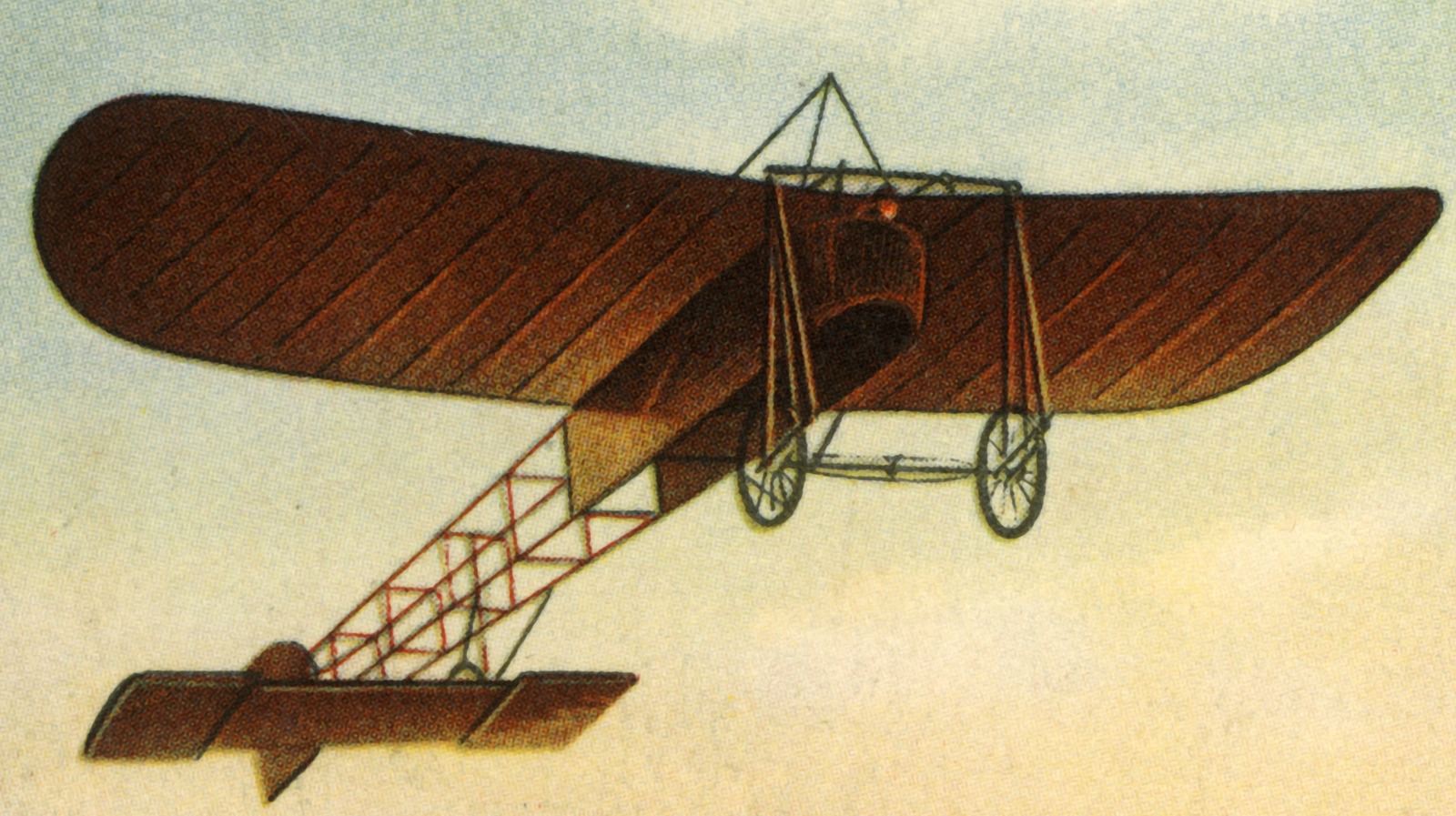
The Incredible History Of The Bleriot XI: The World’s Oldest Plane Still Flying – SlashGear
It’s been over 120 years since the first powered flight piloted by humans left the ground. Wilbur and Orville Wright took to the skies on December 17, 1903, near Kitty Hawk, North Carolina. Their plane flew for thirty-seven meters and stayed airborne for 12 seconds. Those numbers may appear minuscule compared to today’s seemingly effortless hours-long flights, but in 1903, that first flight set the path for progress.
The Wright brothers were far from the first to experiment with flying, but they helped set off a chain of events that led to better designs and longer flights. The progression of flying was rapid, and by 1914, when World War I began, airplanes were designed for military use. Not long after the idea of making a larger-scale profit from flying started to sound pretty good to corporations, the first passenger service flight took off in 1914. This flight was a quick 20-minute trip across Tampa Bay, Florida, between St. Petersburg and Tampa, but those who were a part of it made history.
In modern times, planes look and operate quite a bit differently than they did in the 1900s. Some of the only places one could even lay eyes on one of these pieces of history are aviation museums. Yet, one of the most iconic airplanes in history is still flying: the Bleriot XI.
Louis Bleriot
 Everett Collection/Shutterstock
Everett Collection/Shutterstock
The Bleriot XI gets its name from the French engineer, Louis Bleriot. Bleriot manufactured auto parts, but around 1901, he took an interest in aviation and began to experiment with airplane designs. He began with an ornithopter, which is a machine capable of flight by flapping its mechanical, bird-like wings. After the ornithopter, Bleriot kept designing different variations of equipment he hoped would take to the skies. Very few of these designs were able to stay in the sky for any amount of time, but one success was able to stay airborne for over 10 minutes.
Eventually, one of Bleriot’s designs was improved upon with the help of another engineer. The Type XI was the plane that solidified Bleriot’s seat in history when he successfully piloted it across the English Channel. July 25, 1909, a 25-mile flight between Calais and Dover, stretching 36 minutes and 30 seconds led to many people requesting their own Type XI airplane from Bleriot. The original Type XI that Bleriot made the historic trek in is located in the Conservatoire des Arts et Métiers in Paris, France.
The Bleriot XI had multiple designers
 Apic/Getty Images
Apic/Getty Images
Louis Bleriot was a dedicated innovator in aviation. His designs and flight across the English Channel were, and are still impressive, though there’s a chance his historic 1909 flight wouldn’t have been possible without the design assistance he received after crossing paths with the aerospace engineer Raymond Saulnier. While Bleriot’s initial designs certainly helped, the primary designer of the legendary Bleriot XI was Saulnier. The pair’s designs and engineering backgrounds together birthed a plane that would prove to be a marvel.
Raymond Saulnier didn’t garner fame from piloting the Bleriot XI, but one could argue that he didn’t need to. Saulnier founded the Morane-Saulnier company in 1911, which found success through designing and engineering aircraft.
Saulnier’s career extended beyond the Bleriot and into the design and implementation of fighter planes alongside fellow names in the aviation industry, such as Roland Garros. Saulnier’s company continued to flourish until 1963 when it was taken over by a different name. Saulnier’s hand in the creation of the Bleriot XI is only a portion of what he did throughout his career but the impressive longevity of the XI is certainly an impressive feat.
The Bleriot’s framework might be surprising
 InsectWorld/Shutterstock
InsectWorld/Shutterstock
Perhaps when one thinks of a plane that first took flight in 1909 still being able to go airborne in today’s skies, something a little more time withstanding than wood might come to mind. As it turns out, the Bleriot XI is made of just that. The plane was made of ash wood, and its frame was reinforced with wire. This type of make is different from the planes we know today, but was good enough to take flight at the time.
As far as engine capacity goes, the Bleriot XI came equipped with a 50-horsepower Gnome seven-cylinder rotary engine. The wingspan on the craft was 32 feet and 5 inches with the wings fixed in their place. Wing warping was utilized for lateral control. The airplane weighed in at 720 pounds before the addition of a pilot. These designs collaborated well enough together for the Bleriot to make its first flight on January 23, 1909, and its historic flight later that same year. However, improvements were made as the plane’s popularity grew among enthusiasts and buyers.
Historic flight across the English Channel
 Print Collector/Getty Images
Print Collector/Getty Images
After years of grueling design work, trial, and error, along with several failed attempts at flight longevity, Louis Bleriot entered the cockpit of the Bleriot XI on July 25, 1909, and made history. In this 36-minute, 30-second flight, the Bleriot did what no other person had done before him. He piloted an aircraft across the English Channel.
The feat earned him notoriety and increased global interest and understanding of the need for human-powered aircraft. Along with the influx of orders received, Bleriot was awarded $2,500 from the London Daily Mail for being the first person to fly across the English Channel. This history-making display of what many still consider to be an engineering marvel is a large reason why the Bleriot XI is still so highly coveted today. The plane may not be a household name, but among historians and aviation enthusiasts, the Bleriot’s flight across the English Channel is a huge piece of technological history.
The Bleriot XI was a World War I asset
 Honza123/Shutterstock
Honza123/Shutterstock
The Bleriot XI’s flight across the English Channel left an impression on people from all over. The impact of its venture was nearly instantaneous with hundreds of orders for Bleriots coming in from various enthusiasts and a multitude of countries. The Bleriot XI began its military career in 1910 when it was accepted into the French and Italian air services.
When World War I started in 1914, the Bleriot XI was still proving to be a useful aircraft and was, at first, utilized for observation, training, and light bombing with the addition of a second seat. However, as the war continued on, many of these Bleriots were used less frequently with some even being grounded as training planes until new pilots were ready for actual in-air sessions. Though technology moved beyond the Bleriot at a rapid pace to meet the demand for combat and observation, the Bleriot still had use as long as military units were utilizing it for training purposes.
Military plane and a stunt plane too
 Heritage Images/Getty Images
Heritage Images/Getty Images
Among those with a desire to own a Bleriot XI plane was John Domenjoz, a Swiss flight instructor for the Bleriot company as well as a popular stuntman in Europe. When Domenjoz purchased a Bleriot, he upgraded the plane’s reinforcement to better suit his tour around Europe in 1914. During this time, Domenjoz took himself and his Bleriot over to South America, where he continued his stunt performances with great success.
Throughout 1914 and 1915, Domenjoz toured the southern and midwestern United States “wow-ing” crowds with his ability to fly in loops. For his daring mid-air stunts, Domenjoz became known by many as “upside-down Domenjoz.” Eventually, he returned to Europe and continued his work as an instructor before returning to the United States 17 years later to find his plane had been sold off to a museum. The plane was fully restored in 1979 by the National Air and Space Museum after the Smithsonian Institution purchased it in 1950.
The Bleriot XI can still fly high today
 Trygve Finkelsen/Shutterstock
Trygve Finkelsen/Shutterstock
After over 100 years, the Bleriot XI’s impact on the progression of aviation is still heavily felt. With how much the plane accomplished in its heyday, it would make sense that it has been long since retired. What’s truly remarkable about this plane, however, is that it’s still capable of flight after all this time.
In 2009, a former commercial pilot, Hugh Schoelzel, flew a 1909 Bleriot XI airplane. With that flight, the Bleriot made history once again as the oldest flying aircraft in the United States and the second-oldest known flying aircraft in the world. In a quote published by Simple Flying, Schoezel said of his time flying the Bleriot, “At the senior end of my flying career I can’t imagine any plane being so rewarding or as much of an honor to fly.” Schoelzel’s experience proves that the Bleriot XI is a timeless and well-respected achievement to many, and it will remain so even years after it finally takes its final tour of the skies.









![[VIDEO] Gelagat Che Ta Tunggu Aaisyah Bersiap Cetus Perhatian Ramai!-“Tengok Penampilan, Tercampaklah Mak Hang!” [VIDEO] Gelagat Che Ta Tunggu Aaisyah Bersiap Cetus Perhatian Ramai!-“Tengok Penampilan, Tercampaklah Mak Hang!”](https://i0.wp.com/murai.my/wp-content/uploads/2024/04/25DCA8CF-C629-4DCA-8597-2CA8819D9297.jpg?resize=150%2C150&ssl=1)














![[VIDEO] Reaksi Tunku Azizah Sambut Birthday Anakanda Tengku Puteri Jihan, Raih Perhatian Ramai! [VIDEO] Reaksi Tunku Azizah Sambut Birthday Anakanda Tengku Puteri Jihan, Raih Perhatian Ramai!](https://i0.wp.com/murai.my/wp-content/uploads/2024/04/Untitled-design-27.jpg?fit=300%2C300&ssl=1)










![[VIDEO] Nadhir Nasar Sambut Birthday Tengku Ameera Cetus Perhatian Ramai”- Nak Kena Bersaing Dengan Kerabat Pulak, Hmm” [VIDEO] Nadhir Nasar Sambut Birthday Tengku Ameera Cetus Perhatian Ramai”- Nak Kena Bersaing Dengan Kerabat Pulak, Hmm”](https://i0.wp.com/murai.my/wp-content/uploads/2024/04/D3415DF6-2464-4794-880F-841EB898C969.jpg?w=768&ssl=1)


































